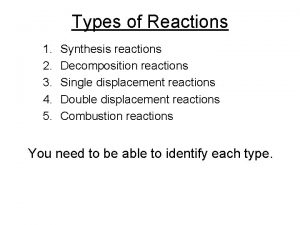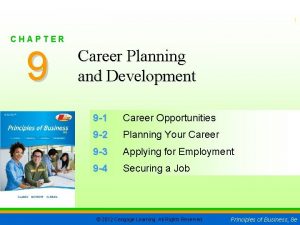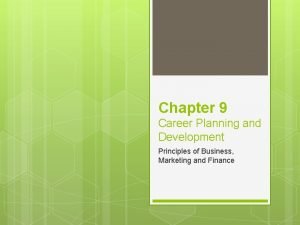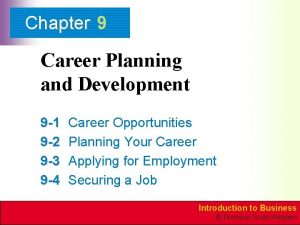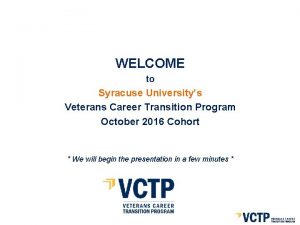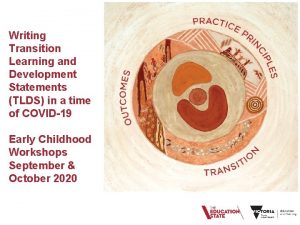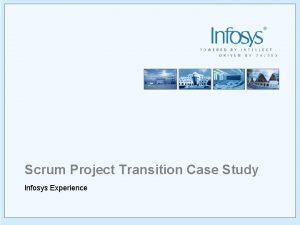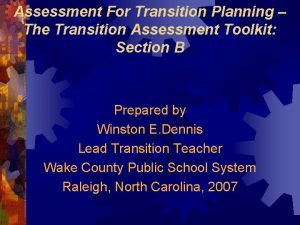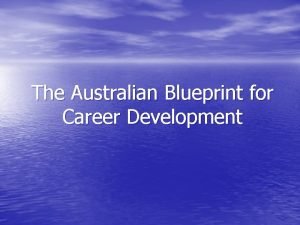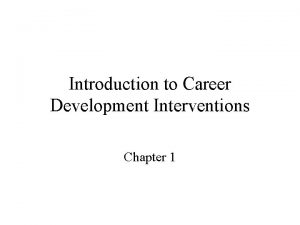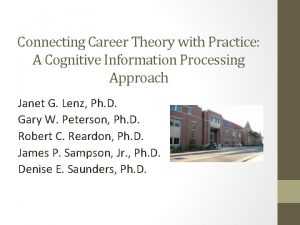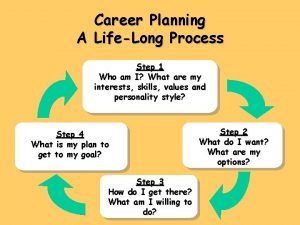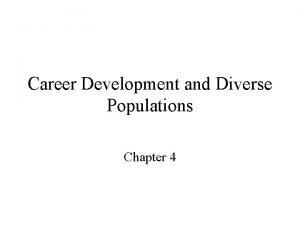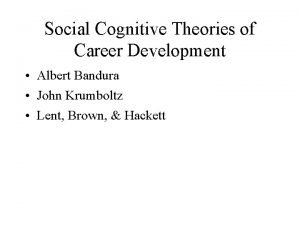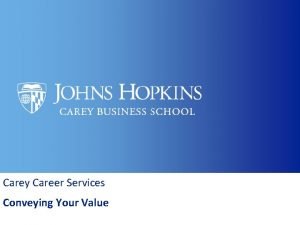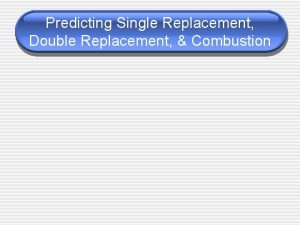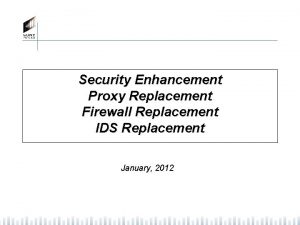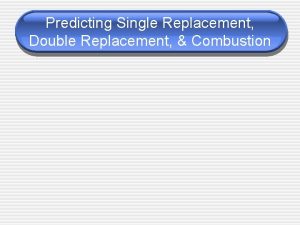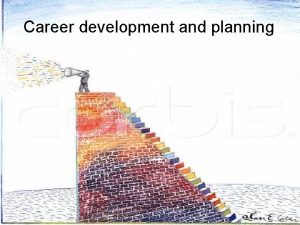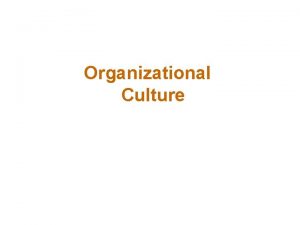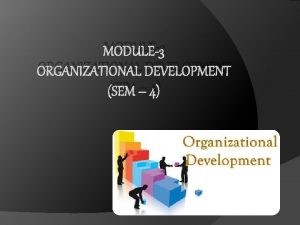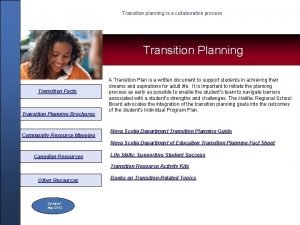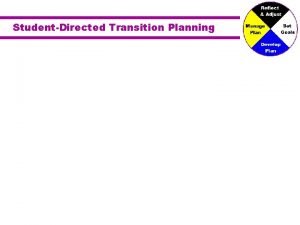ORGANIZATIONAL TRANSITION PLANNING SuccessionReplacement Planning Career Development Replacement


















- Slides: 18

ORGANIZATIONAL TRANSITION PLANNING Succession/Replacement Planning Career Development

Replacement and Succession Planning A deliberate and systematic effort: • to ensure operational and leadership continuity for key areas and positions; • to retain and develop intellectual and knowledge capital for the future; • to encourage individual advancement.

What Replacement/Succession Planning is not • A one time event • Decided by one individual • Choosing someone “like us” or relying on familiarity and comfort with candidates to select. • Recruiting only external candidates for change • Used solely for individual career advancement • Reacting only when a position comes open • One dimensional -there are more components than just selecting a new leader.

Preparing for Successful Transitions Key Strategy Components: • Replacement Plans (risk management/temporary) • Succession Plans (future continuity/enduring) • Career Development Plans (to build the above)

Replacement Plans Replacement planning is a tactical approach of identifying short-term or interim backups to fill critical positions. • Typical criteria involves: • how quickly could you find a replacement • If you were to leave who would be most likely be able(internally or externally) take your role as interim • The number of people you have as back ups in key positions( bench strength)? • Length the interim will serve or is fully prepared for a promotion if considered. • How far down the plan should go in the organization

Replacement Plans Benefits: • Extremely efficient for temporary back ups and provides a good risk management tool • Uses job enlargement and enrichment to cultivate skills as part of career development • Can use internal and external talent to fill positions ( temporarily, interim, or growth opportunity) • Foundation for establishing talent pools • Generally can be used more frequently Limitations: • Can deplete bench strength especially in times of crisis • Replacement planning is based on the premise that an organization chart will remain the same over time. • Replacements may or may not be considered for advancement.

Succession Plans • Succession planning is strategically focused on the long term- the expected and permanent succession to a particular role. • Succession planning criteria typically involves: • An assessment of those currently in existing positions • Strategically identifying new positions or skills that the organization will require in the future • An analysis of the gaps • The development of a plan to fill the gaps with talent that may either be nurtured internally or recruited from outside the organization

Succession Plans Benefits: • Focuses on specific positions, building a competency specific talent pool and individuals within the pool that have the talent or potential to fill a specific position. • It can utilize tactical replacement plans ( via talent pools and stretch goal experiences) to build strategic talent pools for transition plans driven by current and future needs • Can move from an entitlement focus bureaucratic; next in line; or buddy system to successors determined by an open process with multiple inputs and factors • It is driven by individual development plans, readiness assessments or competencies focused on the expected and permanent succession. Limitations: • Although an on-going process, may not be used as often as replacement planning.

Career Development Plans Career Development is the foundation for both Replacement and Succession Planning. It is the adhesive that joins both types of planning. Tools for career development: • In replacement planning: Development through cross training; job enlargement(developing existing or new skills); job enrichment (creating opportunities for achievement and control- self-actualization); progress gauged on ability to fill in temporarily; identifies broad potential talent through demonstration. • In succession planning: Individual development plans or readiness assessments; established competencies that are needed for specific positions; progress is gauged on level of competency needed for position; identifies specific talent through demonstration and competency achievement

Career Development Plans Any Career Development strategy should: • Be a reciprocal agreement between employee and manager • Have clear expectations that the plan or activities do not guarantee promotion or the desired job. • Include relevant competency and skill identification by both the manager and employee; • Be performed as a separate activity from the performance evaluation; • Be more than a one time conversation.

Individual Development Plan (IDP) A Best Practice for Career development is the employee individual Development Plan. The IDP help identify: • The employee’s career aspirations in current or future roles; • The supervisors perspective and feedback on the potential accomplishment of those aspirations; • Ways the supervisor and employee can work together within the resources, budget workload and opportunities for learning to facilitate that development.

A Framework Replacement /Succession Planning • • Identify Key/Critical Positions Conduct analysis of positions identified Develop competencies, attributes and skills needed Establish career development at replacement and succession planning levels. Develop IDPs for all employees that are reviewed annually and can supply internal pipelines to replacement and succession. Develop Replacements Plans down to Functional Levels(for risk management/ talent pool) Develop Succession Plans for all Key Leadership Roles(future leadership/continuity) Monitor, Evaluate, and Revise

FAMU Succession Planning – Comprehensive Framework Successful Transition Succession Planning Replacement Planning Career Development 13

Succession Planning – Comprehensive Framework Career Development Plans (Tools) In replacement planning: • Individual development plans (IDPs) may be used to target areas of interest; • Development through cross training and job enlargement (developing existing or new skills); • Job enrichment (creating opportunities for achievement and empowerment- self-actualization); • Progress gauged on ability to fill in temporarily; • Identifies broad potential talent through demonstration. 14

Succession Planning – Comprehensive Framework Career Development Plans (Tools) ……. continued In succession planning: • Individual development plans or readiness assessments are focused on the expected and permanent succession to a particular role or position; • Competencies that are needed for specific positions are established and developed in the employee; • Progress is gauged on level of competency needed for role or position; • Identifies specific talent and potential through demonstration and competency achievement (e. g. , 9 square; IDP; Competency Gap Analysis). 15

Critical Steps Build the Infrastructure • • • Complete Career Development and Talent Review for Team Members Identify Key/Critical Positions – Aligned with Strategic Plan Conduct analysis of positions identified Develop competencies, attributes and skills needed Establish career development at replacement and succession planning levels Develop Replacements Plans down to Functional Levels (for risk management/talent pool) Develop Succession Plans for Key Leadership Roles (future leadership/continuity) Support ongoing organizational transition as needed Monitor, Evaluate, and Revise 16

FAMU Succession Planning Tools and Resources • FAMU Succession Planning 17

FAMU Succession Planning Questions Thank You! 18
 Example of combustion reaction
Example of combustion reaction Chapter 9 career planning and development
Chapter 9 career planning and development Chapter 9 career planning and development
Chapter 9 career planning and development Chapter 9 career planning and development
Chapter 9 career planning and development Vctp syracuse university
Vctp syracuse university National career clusters framework
National career clusters framework Formulas for career success: résumés - assessment
Formulas for career success: résumés - assessment Veyldf learning and development outcome descriptors
Veyldf learning and development outcome descriptors Software development project transition
Software development project transition Informal and formal assessment
Informal and formal assessment Blueprint for career development
Blueprint for career development Mrc skills development fellowship
Mrc skills development fellowship Career development introduction
Career development introduction Qanxiety
Qanxiety Career development is a lifelong process
Career development is a lifelong process Gage definition
Gage definition John krumboltz social learning theory
John krumboltz social learning theory Carey business school career development office
Carey business school career development office Career opportunities in biotechnology and drug development
Career opportunities in biotechnology and drug development
